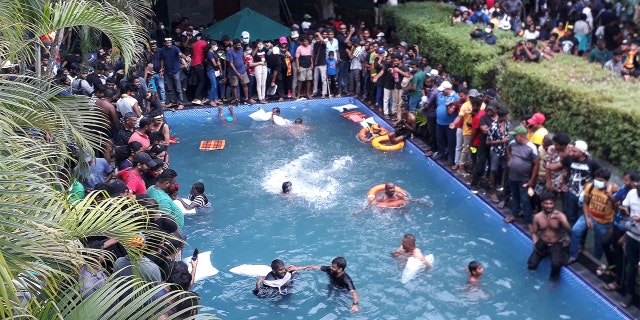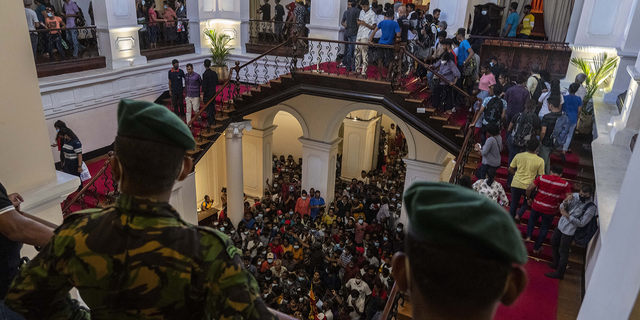NEWYou can now listen to Fox News articles!
New York Times writer German Lopez interviewed colleague Emily Schmall about Sri Lanka protesters’ takeover of their country’s presidential palace in a newsletter published Sunday. During the interview, Lopez compared the Sri Lanka riot to the January 6 riot. The interview also highlighted root causes of the Sri Lanka protests, but neglected to mention the country banning chemical fertilizers.
“Sri Lanka’s recent upheaval offers an extreme example of the world’s recent problems. Covid disrupted the country’s major industries, particularly tourism, and then leaders failed to adapt — setting off a chain of economic calamities, including food and fuel shortages,” Lopez wrote.
“The crisis prompted protests, culminating in the president’s resignation and the installation of a new president on Wednesday,” he continued.
“For the past six months or so, economic conditions for everyday Sri Lankans have grown increasingly difficult,” Schmall said.
TRUMP DOMINATES 2024 GOP PRESIDENTIAL NOMINATION STRAW POLL AT TURNING POINT USA SUMMIT
Police use water canon and tear gas to disperse the protesters in Colombo, Sri Lanka, Saturday, July 9, 2022. Sri Lankan protesters demanding that President Gotabaya Rajapaksa resign forced their way into his official residence on Saturday, a local television report said, as thousands of people took to the streets in the capital decrying the island nation’s worst economic crisis in recent memory. (AP Photo/Amitha Thennakoon)
Schmall said that “fuel and cooking gas became increasingly expensive and hard to find” while “inflation soared” and “New government import bans” meant fewer “goods from overseas.”
The New York Times newsletter did not mention that the Sri Lankan government had also banned chemical fertilizers which environmentalists had blamed for water pollution.
Myron Ebell, the director of the Competitive Enterprise Institute’s Center for Energy and Environment, noted that because of this, “all the crop yields have collapsed, they don’t have any tea to sell because the tea harvest is so low. So, they have no revenues to buy stuff from overseas and their own food production for people to eat in Sri Lanka is not there. They’re starving to death.”
“This is all the result of a government decision to limit the access to commercial fertilizer,” Ebell told Fox News Digital.
RECESSION IS ‘HERE’ AND WILL ‘LAST FOR AWHILE,’ FORMER WHITE HOUSE ECONOMIST SAYS
Schmall continued, “In Sri Lanka, there’s a sizable middle class. People are not used to scarcity, so they noticed immediately when things started disappearing from shelves. People were upset about that. And the ability to carry on became all but impossible in the last month or so.”

Protesters demanding the resignation of Sri Lanka’s President Gotabaya Rajapaksa swim in a pool inside the compound of Sri Lanka’s Presidential Palace in Colombo on July 9, 2022. (Photo by AFP via Getty Images)
Because of this, Schmall argued, the protesters intruded the palace. “But the protesters didn’t ransack the place. They started inviting the public to come in, but in an orderly fashion,” she said. “After about 24 hours, a gleefulness overtook the place, and some people swam in the president’s pool.”
“They’d done it: They had forced this extremely powerful president — who was accused of war crimes, who was feared — to leave his own home and even the country. But they did it peacefully, without taking up arms,” she said. She described these events as “a very Sri Lankan sort of revolution” that was “relatively low-key and polite.”
“I can’t help but compare this to the insurrection at the U.S. Capitol. This seemed much more peaceful,” Lopez remarked.
“Oh, yeah. I couldn’t help thinking of it either,” Schmall agreed. “There were several differences. For one, these people were not armed. It was also a bit spontaneous, and there was no clear leader. They did not do it in association with any politician or political party.”

Army officers stand guard as people throng President Gotabaya Rajapaksa’s official residence for the second day after it was stormed in Colombo, Sri Lanka, on July 11.
(AP/Rafiq Maqbool)
She continued, “But the big difference was that these protesters had widespread support. Ordinary Sri Lankans were applauding them and even participating. People who would otherwise never be involved in activism or protests were happily wandering around the properties, enjoying themselves and basking in the success of this movement.”
Some, such as comedian Tim Young, slammed The Times for the comparison. “YOU CAN’T MAKE THIS UP! The New York Times says that Sri Lankans forcefully overthrowing their government was ‘much more peaceful’ than January 6. And I bet they still wonder why they’re called Fake News…” he tweeted.
In America, inflation is at a 40-year-high, mortgage rates have increased to over 5 percent, and rent is soaring. Voters consistently identity the economy as their top concern, and the current RealClearPolitics polling average shows Trump beating Biden in a 2024 rematch.
Fox News’ Thomas Catenacci contributed to this report.